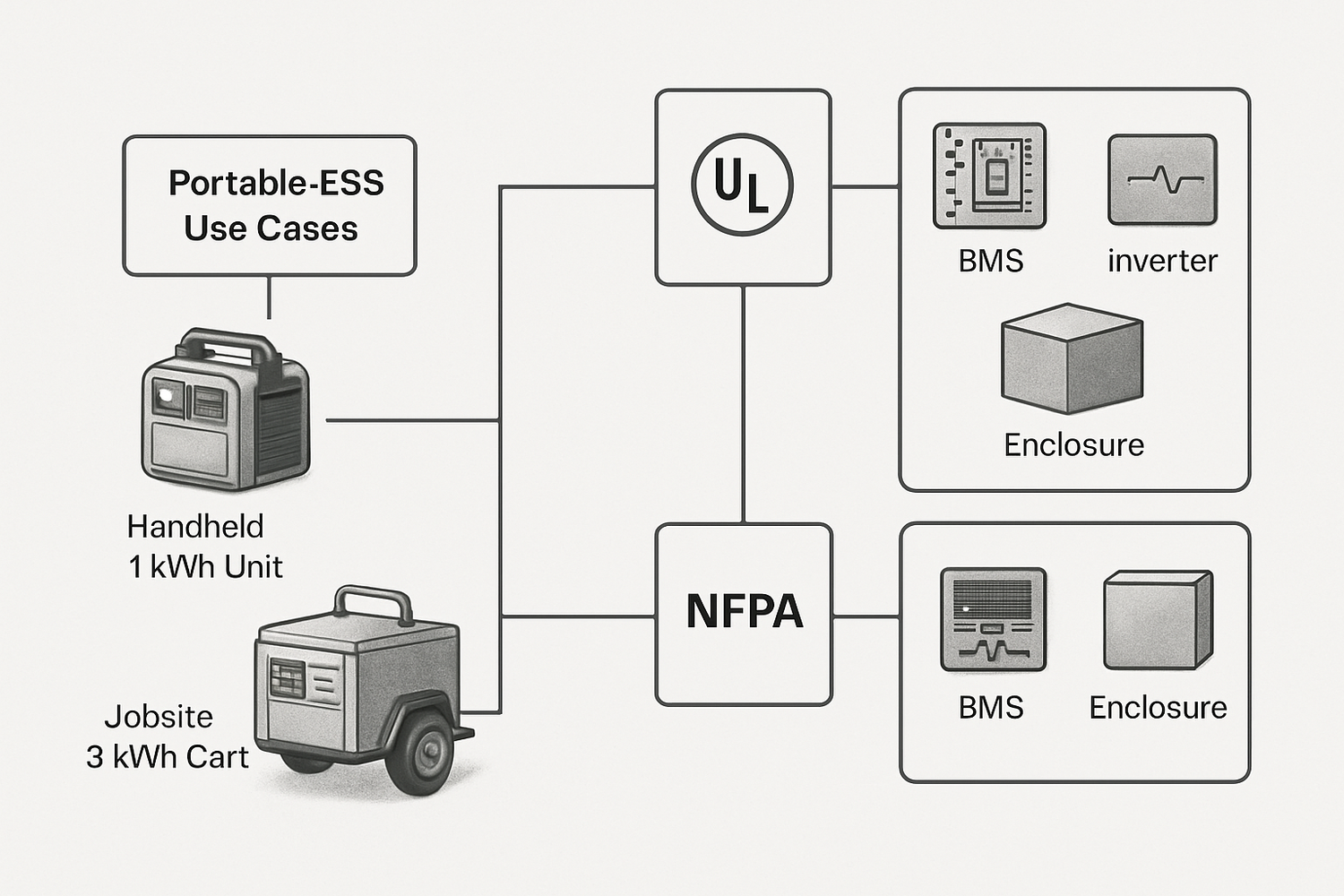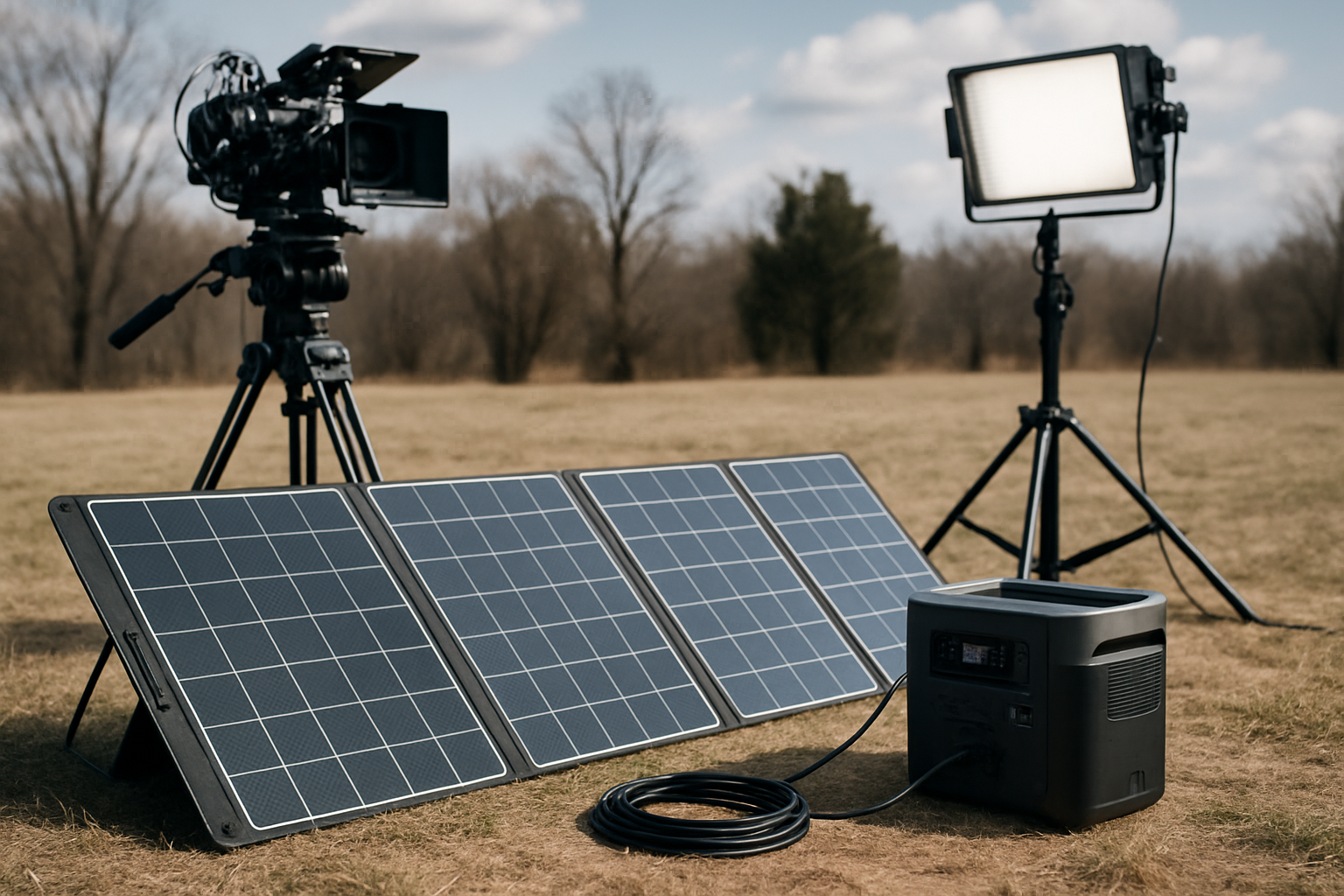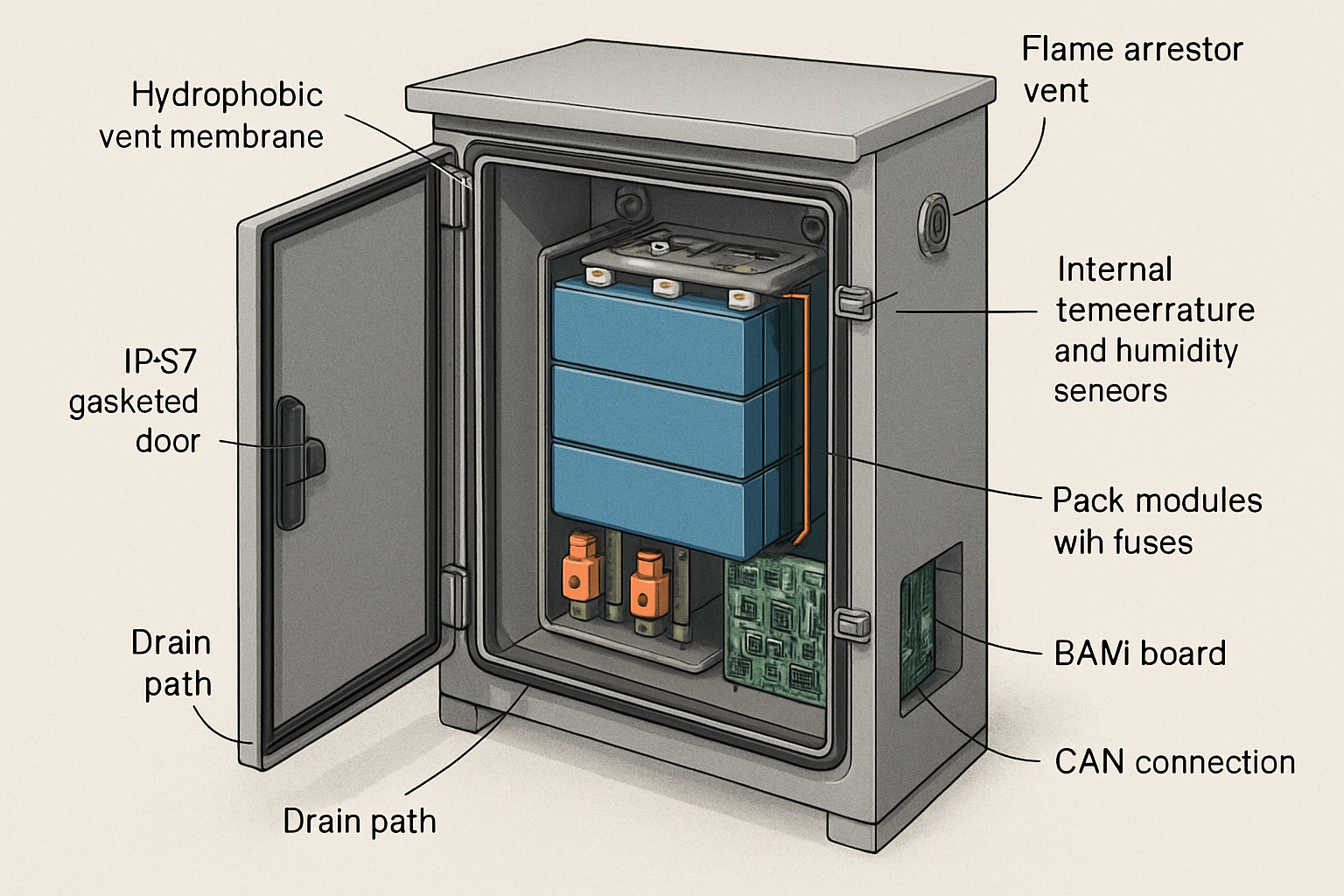Portable energy storage systems sit at the intersection of battery safety, electrical codes, and practical Lithium handling. This piece shows how NFPA and UL standards fit together across real use cases. You’ll see which listings matter, what tests AHJs request, and how to build an evidence-backed compliance file without over-testing or missing critical gaps.

What counts as a portable ESS
In the field, “portable ESS” spans three common types:
- Compact units (100–2,000 Wh). Often hand-carried. DC ports, USB, and a small AC inverter.
- Jobsite carts (2–5 kWh). Rollable frames, higher surge power, swappable packs in some designs.
- Trailer/skid units (5–100 kWh). Towed or forklifted. Used for temporary power, events, or backup at a site without permanent installation.
Each type touches a different slice of NFPA and UL standards. Getting that mapping right keeps you aligned with Fire safety ESS expectations and shortens approval lead time.
UL standards that commonly apply
UL standards define product safety tests and markings. For portable ESS, you’ll usually combine a system-level UL standard with cell/pack and subcomponent standards:
- UL 2743: Portable Power Packs. Widely used for compact and jobsite units with AC/DC outputs.
- UL 9540: Energy Storage Systems and Equipment. Often used for trailer/skid energy systems. Pairs with UL 9540A for thermal runaway propagation testing.
- UL 9540A: Test Method for Evaluating Thermal Runaway Fire Propagation in Battery Energy Storage Systems. Provides data for siting and fire performance claims.
- UL 62133-2: Secondary cells and batteries containing alkaline or other non-acid electrolytes – Safety requirements for portable sealed secondary lithium cells, and for batteries made from them.
- UL 62368-1: Audio/Video, Information and Communication Technology Equipment Safety. Frequently used for AC outlets, USB power delivery sections, displays, and control modules embedded in portable ESS.
- UL 458: Power Converters/Inverters for Land Vehicles and Marine Craft. Relevant for mobile and trailer-mounted inverters not tied to the grid.
- UL 1741: Inverters, Converters, Controllers and Interconnection System Equipment. Applies if the portable unit interfaces with PV or an ac source in a manner covered by this standard.
- UL 1973: Batteries for Use in Stationary, Vehicle Auxiliary Power and Light Electric Rail. Sometimes applied to battery assemblies within higher-capacity portable systems.
- UL 2056: Power Banks. Use this only if you market the product as a power bank under the scope of UL 2056; most “portable ESS” exceed that scope.
Fast mapping: use case to standards
| Portable ESS use case | Primary UL standards | Supporting UL standards | Notes |
|---|---|---|---|
| Compact (100–2,000 Wh) with AC/DC | UL 2743 | UL 62133-2 (cells/packs), UL 62368-1 (USB/ICT), UL 2056 if sold as “power bank” | Focus on BMS protections, thermal abuse, drop, short-circuit, charging safety, and markings. |
| Jobsite cart (2–5 kWh) | UL 2743 | UL 62133-2, UL 62368-1, UL 458 for mobile inverter sections as applicable | Higher fault current and surge. Mechanical stability and ventilation become more important. |
| Trailer/skid (5–100 kWh) | UL 9540 | UL 9540A (propagation test), UL 1973 (battery assemblies), UL 458 or UL 1741 (inverter/controller) | AHJs often ask for UL 9540 plus 9540A data to support siting and fire protection measures. |
NFPA and NEC alignment for portable ESS
UL listings cover product safety. NFPA codes guide installation, use, and fire protection on site. For portable ESS, the most cited references are:
- NFPA 70 (NEC): Article 706 addresses Energy Storage Systems, while Article 480 covers storage batteries. Cord-and-plug portable units may fall outside some installation rules, yet event and temporary setups still follow general NEC safety and labeling expectations.
- NFPA 855: Installation of Stationary Energy Storage Systems. Trailer/skid units that act as temporary installations are often reviewed against NFPA 855 principles, using UL 9540/9540A data.
- NFPA 1 (Fire Code) or local fire codes: Used by AHJs to set indoor/outdoor placement, ventilation, supervision, aggregate capacity limits, and emergency procedures for portable equipment in public or commercial spaces.
The goal is ESS NFPA UL compatibility: a listed product with clear instructions, used in a way that meets fire code intent. In practice, AHJs want a clean link between the UL reports and your operating limits, floor plans, and emergency actions.
AHJ questions you should expect
- Which UL listing covers the complete system? If modular, how do pack and inverter listings stack up?
- Do you have UL 9540A data for propagation, gas release, and heat flux (for larger units)?
- What are the labeled limits for temperature, altitude, charge rate, and continuous load?
- What procedures exist for supervised charging, storage, and incident response?
A practical compliance roadmap
1) Choose the correct compliance path early
Define the primary use case. Hand-carried consumer unit? Jobsite tool power? Trailer-based temporary supply? This choice sets the primary UL standard and which NFPA chapters your AHJ will use.
2) Build a right-sized test plan
Coordinate with a NRTL and agree on the minimum complete set of tests. Overlapping tests waste budget; missing tests delay approvals.
| Test bucket | Typical coverage | Why it matters |
|---|---|---|
| Electrical abuse | Overcharge, short-circuit, reverse polarity | Validates BMS cutoffs and single-fault tolerance. |
| Thermal | Over-temperature, thermal stability, enclosure temperature rise | Supports safe operation in hot/cold sites and closed vehicles/rooms. |
| Mechanical | Drop, vibration, impact, crush (as applicable) | Addresses portable use, transport, and jobsite hazards. |
| Propagation (large systems) | UL 9540A cells, modules, unit-level | Provides data for NFPA-based siting and fire brigade planning. |
| EMC and functional | Basic emissions/immunity and control reliability | Reduces nuisance trips and ensures stable BMS/inverter behavior. |
3) Design details that ease UL and NFPA reviews
- Protections: Independent sensing for OVP, UVP, OCP, OTP. Show single-fault tolerance and fail-safe states in your safety analysis.
- Enclosure and materials: Use polymeric parts with flammability ratings acceptable under your chosen UL standard. Secure cells to limit movement and damage under drop and vibration.
- Wiring and creepage/clearance: Size conductors for worst-case duty. Maintain spacing per the applicable standard and pollution degree.
- Thermal path: Provide heat spreaders or thermal interface materials to keep surface temperatures within limits. Document thermal tests at max ambient and continuous load.
- Markings and instructions: Clear ratings, limits, and Lithium handling cautions. Include placement, charge supervision, and storage temperature ranges that match your test data.
Field-proven scenarios
Compact 1 kWh unit for events
Path: UL 2743 (system), UL 62133-2 (cells/packs), UL 62368-1 (USB/AV interfaces). Provide instructions controlling charging indoors, supervision during public events, and max daisy-chain limits. For Fire safety ESS in event halls, the AHJ typically reviews your labels and MSDS/SDS, evacuation notes, and unit count per room. No NFPA 855 install is triggered, yet NFPA 1 goals still shape oversight.
Jobsite 3 kWh cart
Path: UL 2743 with higher mechanical tests, UL 62133-2, and UL 458 for a mobile inverter if used on vehicles. Add heavy-duty strain reliefs, guarded terminals, and documented 24/7 storage practices. Provide maintenance steps for dust, connectors, and periodic BMS checks.
Trailer 20 kWh system
Path: UL 9540 plus UL 9540A. Subassemblies may use UL 1973 for battery units and UL 458 or UL 1741 for the power stage. Share 9540A heat release and gas data with the AHJ to set separation, ventilation, and emergency actions consistent with NFPA 855 principles. Provide a shutoff plan, signage, and a simple one-page incident playbook.
Standards and energy performance: small choices that matter
Safety listings are not the whole story. Energy performance and standby draw change real risk too. According to the IEA’s overview of external power supply standards, standby power at or below 0.5 W became a design target in the United States under the Energy Independence and Security Act, with phased updates from 2008 to 2013. See the summary in Transforming Global Markets for Clean Energy Products. Designing your charger module and control electronics to low-idle targets reduces heat and extends component life.
The IEA also notes that safety standards for battery trade, charging, and testing are priority areas for alignment across markets. That reinforces why a clear NFPA–UL map improves procurement and approvals. See Energy Technology Perspectives 2024.
Documentation package that wins fast approvals
- Cover sheet: Product description, use case, chemistry, kWh, voltage class, and the target UL standard.
- Bill of safeguards: All protective functions with thresholds and test evidence. Include BMS logic flow and fault trees.
- Thermal dossier: Worst-case temperature maps at ambient extremes, continuous and peak loads.
- Test reports: Final NRTL reports for UL 2743/9540 and supporting standards, plus 9540A (if applicable).
- Labels and IFU: Markings, pictograms, and a plain-language instruction manual. Show Lithium handling steps for charging, storage, and transport handoff.
- Field SOPs: Supervised charging, storage, emergency shutdown, and post-incident checks.
Why this approach works
In lab reviews for portable ESS, the friction usually comes from unclear scope. A compact unit tested as a power bank will stall approvals if marketed as a jobsite tool. A trailer unit without 9540A data will face placement questions from the fire marshal. Map the use case early, select the right UL path, then tie NFPA intent to your labeled limits and site procedures. That is the heart of ESS NFPA UL compatibility.
Non-legal notice
This content supports engineering and safety planning. It is not legal or compliance advice. Always consult your NRTL, AHJ, and qualified code professionals for binding interpretations.
References
- According to the IEA’s product efficiency summary, EPS standby limits of 0.5 W shaped mainstream designs in the US market. See Transforming Global Markets for Clean Energy Products – 2010.
- The IEA flags safety standards for battery trade, charging, and testing as near-term priorities for harmonisation; see Energy Technology Perspectives 2024.
- DOE’s solar topic hub provides policy and technical context for safe, reliable distributed energy; see U.S. Department of Energy – Solar Energy.
- IRENA offers broader system integration and safety context across clean energy deployment; see IRENA.
- EIA supplies market and technology baselines that inform safety and deployment planning; see U.S. Energy Information Administration.
- For country-level policy context on energy standards and governance, see the IEA report Energy Policies beyond IEA Countries: Morocco 2019.
- On system performance frameworks and flexibility, see Status of Power System Transformation 2018 – Technical Annexes.





Leave a comment
All comments are moderated before being published.
This site is protected by hCaptcha and the hCaptcha Privacy Policy and Terms of Service apply.